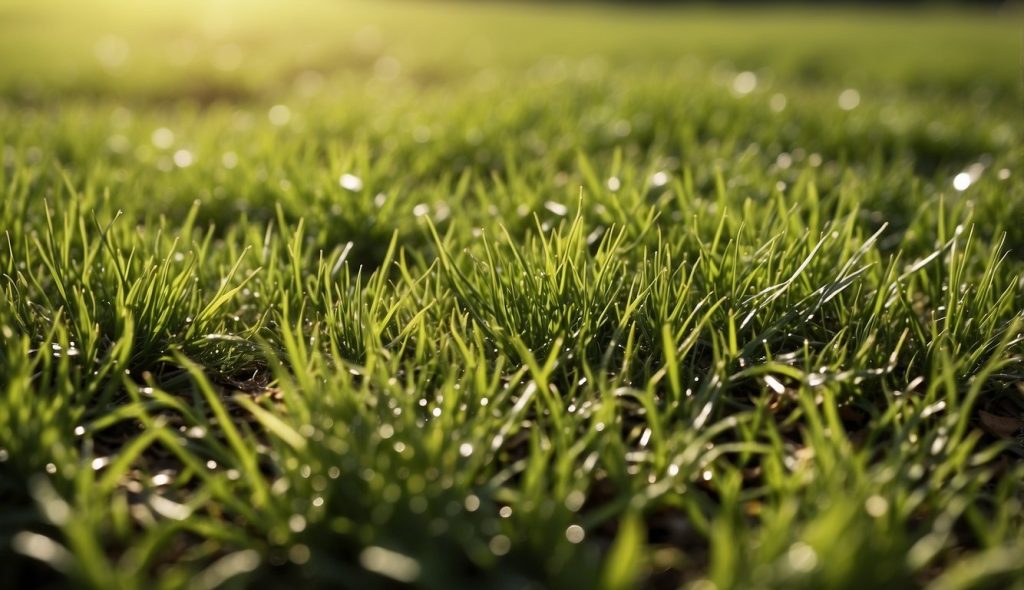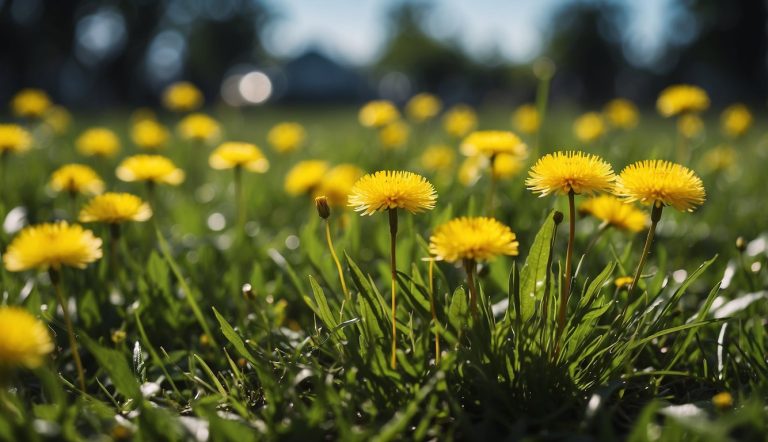What Is Dollar Spot Disease in Lawns? – Identify and Treat Your Turf Troubles!
Dollar spot disease is a common and often frustrating challenge for anyone passionate about maintaining a healthy lawn.
Recognized by small, circular patches that are straw-colored and roughly the size of a silver dollar, this fungal ailment can affect various types of turfgrass under certain conditions.
As a lawn enthusiast, I’ve seen firsthand how this pathogen, caused by the fungus Sclerotinia homoeocarpa, can mar the appearance of what would otherwise be a lush, green carpet.

Understanding the factors that lead to dollar spot is crucial for prevention and management.
Insufficient lawn nutrition, particularly low nitrogen levels, renders grass more vulnerable to disease.
Moreover, environmental conditions like high humidity, excessive moisture, and cool night temperatures create an ideal setting for the fungus to thrive and spread.
As frustrating as it may be to spot these blemishes on my turf, it’s reassurance to know that with the right knowledge and commitment, dollar spot can be controlled and even prevented.
Key Points
- Dollar spot disease causes distinctive small, straw-colored patches on turfgrass.
- The disease thrives in specific environmental conditions and on undernourished lawns.
- Effective control requires proper lawn care and environmental management.
In This Article…
What is Dollar Spot in Lawns?
Dollar spot disease is something I often notice as a common issue in lawns, including my own backyard. It’s a fungal disease that affects different types of grass, creating distinct circular patches. These patches are typically the size of a silver dollar, giving the disease its name.
When I observe my lawn for symptoms, I look for small tan or straw-colored spots that can merge into larger areas if left unchecked. The grass in those spots often has lesions on the blades, which are usually bleached white or light tan with a reddish-brown border.
The disease is caused by the fungus Sclerotinia homoeocarpa and can spread mycelium, which is like a fungal web, in the morning dew. This is more than just a cosmetic issue; it can weaken my lawn if I don’t manage it properly.
For lawn enthusiasts like me, taking a closer look reveals more about dollar spot. The affected areas, when dew is present, may exhibit mycelium, resembling cobwebs. These signs are my queue to take action to prevent further damage to my beloved turf.
It’s interesting that even though dollar spot can affect various grass types, it’s particularly partial to creeping bentgrass, Kentucky bluegrass, perennial ryegrass, and zoysia grass.
But don’t worry, being aware of the issue is the first step in tackling it. Just keep an eye out for those small, silvery spots on your lawn, especially during warm, wet periods.
What Causes Dollar Spot in Lawns?
Dollar spot is a common lawn disease that stems from a specific type of fungal pathogen and thrives under certain environmental conditions. Maintaining proper lawn health and adhering to effective maintenance practices can significantly decrease the risk of an outbreak. Now, let’s explore the environmental factors and lawn maintenance practices that contribute to dollar spot in lawns.
Environmental Factors
This turfgrass disease loves moisture, high humidity, and cool nights, which are ideal for its development. Dew formation on grass blades can also facilitate its growth.
When the humidity, moisture, and temperature conditions align, particularly in the late spring through autumn, the risk of dollar spot increases.
- Ideal Conditions for Dollar Spot:
- High humidity
- Adequate moisture on grass blades, especially dew
- Cool nighttime temperatures
Lawn Health and Maintenance
How I care for my lawn plays a pivotal role in either suppressing or encouraging dollar spot. For instance, when I fertilize my lawn with the right amount of nitrogen, it improves the turf’s ability to resist fungal diseases.
Mowing should be done at the right height to avoid stress on the grass—usually between 3 to 4 inches for most turf types. Improper mowing leaves the grass blades susceptible to infections.
- Key Maintenance to Prevent Dollar Spot:
- Regularly aerate the soil to improve moisture penetration and control thatch.
- Water the turf adequately but avoid over-watering to prevent excessive moisture.
- Apply a balanced amount of nitrogen-based fertilizer according to your lawn’s specific needs.
Identification and Symptoms
When I look for signs of dollar spot disease in lawns, I focus on a couple of key visual clues and the overall health of the grass.
Visual Indicators
I always start with what’s most apparent to the eye: small, round patches about the size of a silver dollar. These patches often turn brown and can merge into larger areas when the disease spreads.
On closer examination, I notice the grass blades within these spots become a straw-colored hue, sometimes with a reddish-brown margin. The mornings are particularly telling—when it’s moist, I might see a cobweb-like white fungus on the foliage.
Grass and Turf Analysis
As I delve deeper, examining the grass itself helps me understand the extent of the problem. Discolored spots on individual grass blades arise, transitioning from healthy green to brown or straw-colored near the base. This pattern usually looks like an hourglass.
I find these symptoms are more pronounced under certain conditions, like when the lawn is consistently wet from dew, irrigation, or rain.
Preventative Measures
To keep our lawns healthy and free of dollar spot disease, I follow a series of preventative actions. These actions fit into two main categories: cultural practices, which are all about how I maintain my lawn, and chemical prevention, which involves the use of products to resist and inhibit the growth of the fungus.
Cultural Practices
Watering: I ensure proper watering techniques because overwatering can contribute to the development of dollar spot. It’s best to water deeply but infrequently, promoting deep root growth and reducing thatch.
Morning watering lets the turf dry out over the course of the day, which is less hospitable for the fungus.
Fertilization: Regular, balanced fertilization is key. I apply enough nitrogen to sustain healthy growth without overfeeding, which can lead to excess thatch and vulnerability to disease.
Aeration: Periodically aerating the lawn helps prevent compaction, improves drainage, and allows more oxygen to reach the roots, making the grass stronger and less susceptible to dollar spot.
Proper Mowing: Mowing practices matter. I always use sharp blades to avoid tearing the grass, which can cause necrosis at the tips and make them more prone to fungal attack.
I mow at the recommended height for my grass type—never removing more than one-third of the grass blade length at a time.
Thatch Management: I keep an eye on thatch buildup and remove it as necessary. A thick thatch layer holds moisture and creates an environment where dollar spot can thrive.
Chemical Prevention
Fungicide Application: I use fungicides carefully, alternating products to prevent resistance. It’s important to start applications before signs of dollar spot appear, especially if my lawn has a history of the disease.
Choosing Resistant Cultivars: When overseeding or establishing a new lawn, I select turfgrasses that have natural resistance to dollar spot. Some cultivars of tall fescue, ryegrasses, bluegrasses, zoysiagrass, and creeping bentgrass are less prone to the disease, which helps me minimize lawn diseases overall.
How do you get rid of dollar spot lawn disease?
If you’ve spotted those telltale silver-dollar-sized patches on your lawn, chances are you’re dealing with dollar spot. I’ll guide you through using fungicides effectively and maintaining your lawn to combat this stubborn disease.
Fungicide Use
When I tackle dollar spot, my first line of defense often involves applying a fungicide. It’s essential to choose a product that targets this specific lawn disease.
I’ve learned that fungicides containing chlorothalonil or fluazinam are particularly effective. It’s crucial to follow the instructions for application rates and frequency to ensure the best results.
If the disease persists, I might apply the fungicide every 7 to 14 days, as this can help to keep the infection in check.
Lawn Care and Recovery
My experience tells me that good lawn care is key to not only treating but also preventing dollar spot. Here’s what I focus on:
- Fertilizer: I feed my lawn with a balanced fertilizer that includes enough nitrogen, which supports healthy growth and can suppress disease development.
- Irrigation: Watering is best done in the early morning hours to minimize heavy dew, which can promote disease. I aim for deep, infrequent watering to encourage dry soils and robust roots.
- Aeration: To improve air circulation around the grass, I regularly aerate my lawn, reducing soil compaction and helping control the disease.
- Disease Management: Vigilantly removing infected plant parts and avoiding the spread of disease are integral to my disease management practices.
Frequently Asked Questions
I’ve gathered some common questions about dollar spot disease that might be on your mind. If you’re dealing with this fungus, understanding these aspects can help you manage it better.
How can I identify dollar spot disease in my lawn?
You’ll spot small, tan, and circular patches that could be the size of a silver dollar on your lawn.
These marks are telltale signs of dollar spot disease, and you might also see a silver-colored fungus.
What are the best treatment options for dollar spot?
The approach to handling dollar spot includes applying fungicides and changing your lawn care techniques.
Ensuring proper fertilization and watering can help, and you can learn more about the treatment options from Lawn Doctor.
Are humans at risk from dollar spot fungus?
Thankfully, dollar spot fungus doesn’t pose a threat to humans. It’s primarily a concern for the health of the grass and the overall appearance of your lawn.
How does dollar spot differ from brown patch disease?
The main difference lies in their appearance and conditions they favor. Dollar spot is recognized by small, silver dollar-sized patches, while brown patch disease typically presents larger, more irregular areas of damage.
Additionally, brown patch thrives in high humidity, which is slightly different from the conditions favoring dollar spot development.
What environmental conditions promote dollar spot development?
Dollar spot loves humidity and moderate temperatures. Nighttime moisture conditions, like dew and light rain, can be especially conducive to its spread.
Keep in mind, a lawn that’s mowed too short is also more vulnerable to infection.
What are effective strategies for preventing dollar spot in lawns?
Preventing dollar spot starts with good lawn care practices. Maintain a balanced level of nitrogen, avoid overwatering, and ensure you’re mowing at the correct height.
Implementing these strategies consistently can be your best defense against this pesky fungus. For more detailed strategies, The Grass Master has some great insights.







